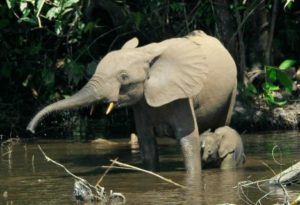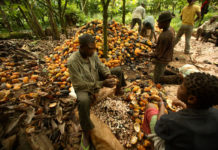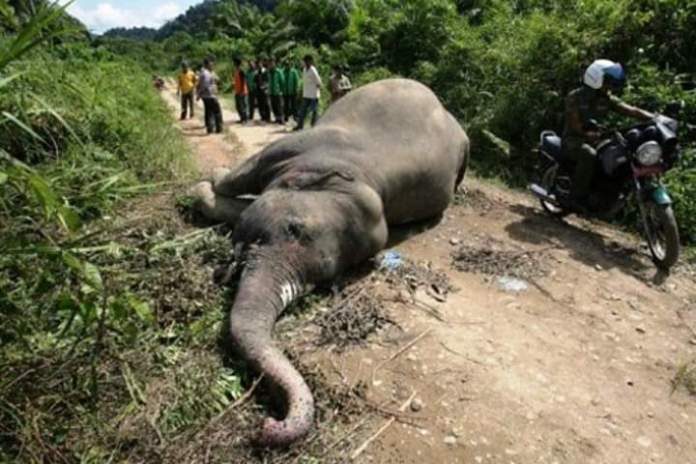Forest elephants killing have been a long time tradition for many rural hunters in Liberia especially south-eastern part of the country.
Some hunters in that part of the country according to report are hailed for their bravery for gunning down gigantic animals like forest elephants, Tiger, antelopes, and other endangered species.
In 2008, a hunter in Rivergee county (now late) was interviewed on Star Radio 104.1 who admitted killing more than 150 forest elephants in his hunting career. Liberia’s forestry Development Authority (FDA) and partners have been fighting against the unlawful killing of elephants mainly around the country’s protected areas which includes Sapo National Park and other national reserves.
In continuation of the fight against illegal hunting of endangered animals, the Forestry Development Authority (FDA) in Sinoe County arrested a 60 year old hunter for allegedly killing four elephants in the Sapo National park.
How the elephants were killed?
On Saturday, April 27, 2019, the hunter, only known as Jarwee, according to the report, illegally entered the Jleepo Forest, near the National #1 Nature Reserve around Nelson village and hunted the animals down.
It remains unclear what type of weapon Jarwee used to kill the animals, but an eyewitness claimed to have spotted him with a well-loaded automatic rifle.
According to report obtained by the Daily Observer, Jarwee allegedly killed the four elephants in early March, but FDA rangers, who were on a recent foot patrol discovered the decomposed bodies of the elephants, without their tusks.
Elephants are among some of the world’s endangered species, and one of most protected animals in Liberia.
“Upon the discovery of the dead elephants,” the park warden, Alexander Gbarway, said they applied all efforts to bring the culprit to book, but have not succeeded, owing to the density of the forest.
Gbarway added, “Under the law, if anyone kills wildlife illegally, said person(s), when found guilty by a court of competent jurisdiction, can be sentenced up to four to five years or be fined an undisclosed sum of money.”

Meanwhile, Daily Observer newspaper quoted some of the residents in Nelson Village as saying the Jarwee is an old hunter, who has been in the business since 1980, but was in the constant habit of targeting wild animals, specifically elephant for its tusks.
Elephant tusks are sometimes shipped to china and other parts Asia where they can be sold for thousands of United States dollars.
They therefore called on the FDA to conduct further investigation as the killing of the animals may have involved several other known hunters.
The Sapo National Park is Liberia’s largest protected area of rainforest. It contains the second-largest area of primary tropical rain forest in West Africa after Tai National Park in neighboring La Cote d’Ivoire.
In the Upper Guinea Ecosystem, Liberia has about 48 percent of the rain forest, according to the FDA.
Since its establishment in 1983, the Sapo National Park has been face with many threats from illegal hunters and miners from Liberia and neighboring countries.
Why is elephant so important?
As icons of the continent, elephants are tourism a magnet, attracting funding that helps protect wilderness areas. They are also keystone species, playing an important role in maintaining the biodiversity of the ecosystems in which they live. During the dry season, elephants use their tusks to dig for water (interesting).
Elephant decline in Liberia
Liberia was once a home to African elephants that accounted for almost 50% in the 19th century, but lost 95 percent of its elephant population meaning, only 1,000 elephants remain, this happened in only a few decades.
Across Africa, elephant populations have dropped precipitously since the end of the 19th century, when it was estimated that elephants numbered between 5 and 10 million.
In 2017, former Ellen Johnson Sirleaf formally signed off on a National Elephant Action Plan (NEAP) – devised by Fauna & Flora International (FFI) and partners and funded by Stop Ivory – to help tackle the growing threats to the country’s forest elephants.
This important achievement placed Liberia in a strong position internationally to attract much-needed support for elephant conservation.
Liberia’s elephant population is extremely important; the country provides the largest forest cover out of the 8 African countries through which forest elephants travel.






















![EPA Debunks Daylight’s Reports about concealing findings on Bea Mountain pollution A resident of Cape Mount one of the polluted villages speaks to Daily Observer [photo: Liberian Observer ]](https://liberiapublicradio.com/wp-content/uploads/2023/04/varney-a-resident-of-Cape-Mount-points-to-polluted-water-100x70.png)